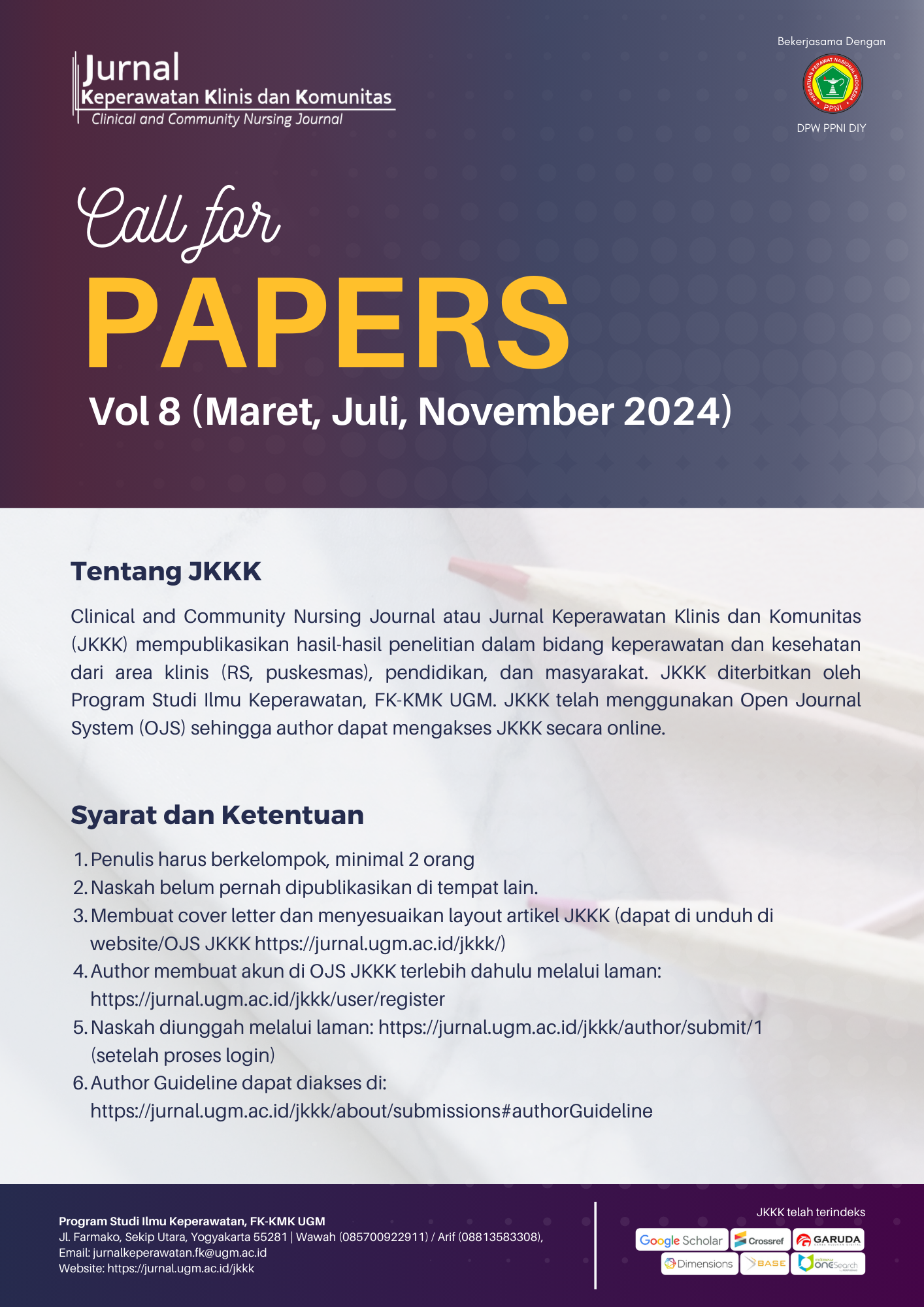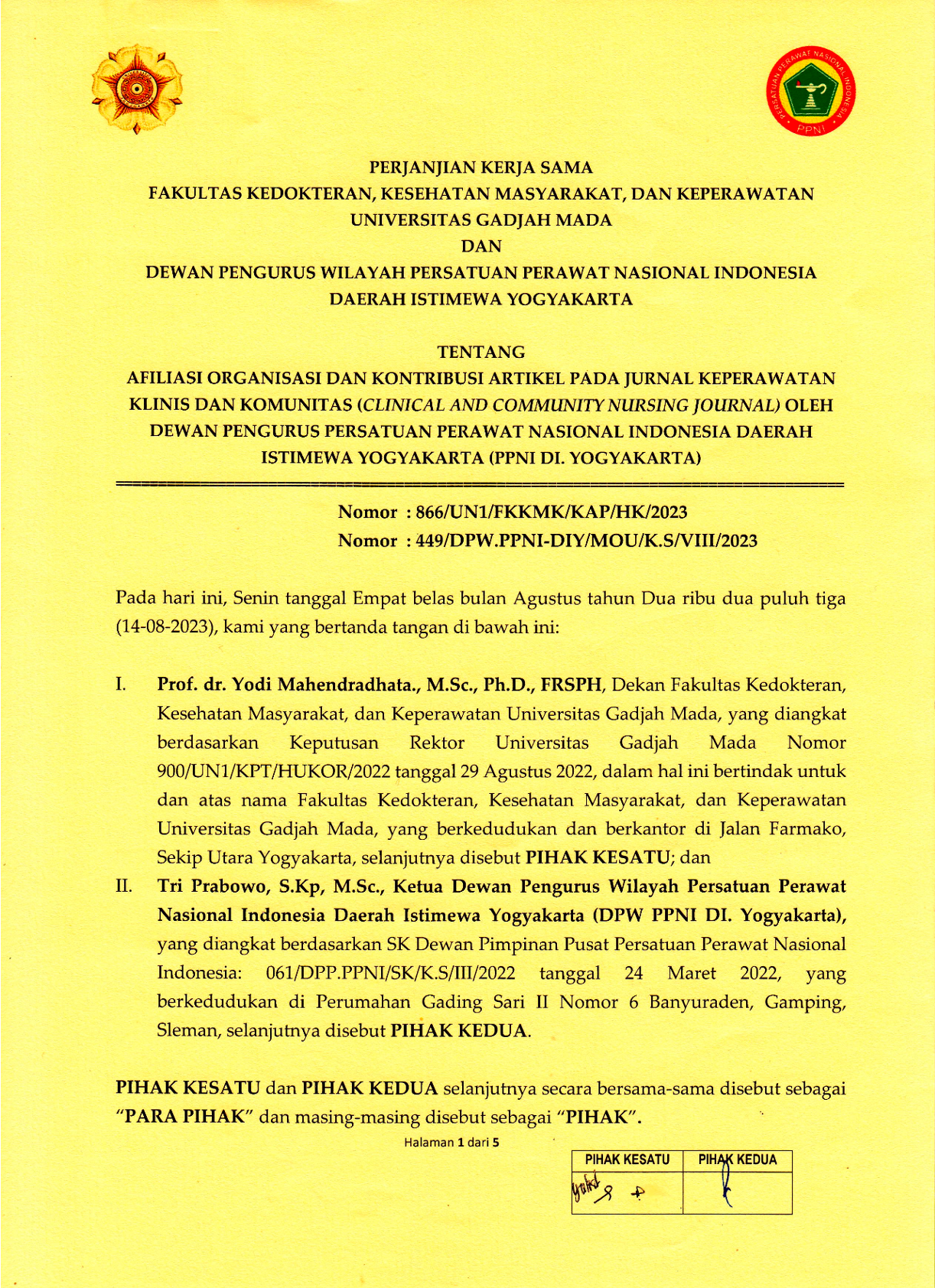Electronic Patient Reported Outcomes (ePROs) dalam Pengukuran dan Pemantauan Gejala pada Anak dengan Kanker: Studi Literatur
El Nino Tunjungsari(1*), Allenidekania Allenidekania(2)
(1) Program Studi Magister Ilmu Keperawatan, Fakultas Ilmu Keperawatan, Universitas Indonesia
(2) Departemen Keperawatan Anak, Fakultas Ilmu Keperawatan, Universitas Indonesia
(*) Corresponding Author
Abstract
Background: The incidence of cancer in children is estimated to increase in the future, on the other hand, health care providers rarely detect the burden of the symptoms felt by children with cancer. Effectively reported and measured subjective symptoms could increase the quality of interventions that affected children’s health-related quality of life (HRQoL). Recently, Electronic Patient-Reported Outcomes (ePROs) have been widely applied in the assessment, monitoring, and evaluation of interventions on symptoms that mostly experienced by adult cancer patients, while the application of ePROs in pediatric patients is still not widely developed.
Objective: To describe the application of ePROs in children with cancer in the last decade.
Method: This was literature review research. Articles searched through online databases, i.e. Proquest, Science Direct, Research Gate, and Google Scholar that were published in the last 10 years (2012 to 2021), with keywords electronic patient-reported outcomes and pediatric cancer.
Result: There were nine articles found. It was found that ePROs were more developed by High-Income Countries (HIC). Furthermore, the measuring tools used in ePROs determined the user's age and measured symptoms. Moreover, ePROs was easy to use and provided more benefits for users and health care providers. Meanwhile, there were technical and organizational barriers in their development.
Conclusion: Symptom measurement tools that are synchronized to the user's age will make ePROs an effective symptom measurement tool in children with cancer. The use of ePROs in pediatric patients with cancer is positively affecting patients.
ABSTRAK
Latar belakang: Angka kejadian kanker pada anak diperkirakan meningkat dari tahun ke tahun. Namun, di sisi lain, penderitaan yang dirasakan oleh anak dengan kanker sering tidak terdeteksi oleh tenaga kesehatan. Gejala-gejala subjektif yang dialami oleh pasien anak dengan kanker jika dilaporkan dan didokumentasikan dengan baik, telah terbukti meningkatkan intervensi sesuai dengan prioritas gejala yang paling mengganggu kualitas hidup anak. Belakangan ini, Electronic Patient Reported Outcomes (ePROs) telah banyak dimanfaatkan dalam pengkajian, pemantauan, hingga evaluasi terhadap intervensi pada gejala yang dialami oleh pasien kanker dewasa. Namun, penggunaan ePROs pada pasien anak masih belum banyak dikembangkan.
Tujuan: Untuk menggambarkan penggunaan ePROs pada anak dengan kanker dalam satu dekade terakhir.
Metode: Penelitian ini menggunakan pendekatan studi literatur. Artikel dicari melalui database daring yakni Proquest, Science Direct, Research Gate, dan Google Scholar yang diterbitkan dalam 10 tahun terakhir (2012-2021) dengan kata kunci electronic patient reported outcomes dan anak dengan kanker.
Hasil: Diperoleh 9 artikel yang sesuai dengan kriteria. Ditemukan bahwa ePROs lebih banyak dikembangkan oleh negara-negara berpenghasilan tinggi. Kemudian, alat ukur yang digunakan dalam ePROs akan berpengaruh terhadap usia pengguna dan gejala yang diukur. Lebih jauh lagi, pengguna merasa bahwa ePROs mudah digunakan dan lebih banyak memberikan keuntungan dan manfaat, baik bagi pengguna maupun penyedia layanan kesehatan. Akan tetapi dalam pengembangan ePROs terdapat beberapa hambatan teknis dan organisasi.
Simpulan: Alat ukur gejala yang disesuaikan dengan usia pengguna akan membuat ePROs menjadi alat ukur gejala yang efektif pada anak dengan kanker. Penggunaan ePROs pada pasien anak dengan kanker juga terbukti mempunyai dampak positif terhadap pasien.
Keywords
Full Text:
PDFReferences
Lam C, Howard S, Bouffet E, Pritchard-Jones K. Science and Health for All Children with Cancer. Science. 2019;363(6432):1182–1186.
Pinheiro LC, McFatrich M, Lucas N, Walker JS, Withycombe JS, Hinds PS, et al. Child and adolescent self-report symptom measurement in pediatric oncology research: a systematic literature review. Qual Life Res. 2018;27(2):291–319.
Skeens MA, Cullen P, Stanek J, Hockenberry M. Perspectives of Childhood Cancer Symptom-Related Distress: Results of the State of the Science Survey. J Pediatr Oncol Nurs. 2019;36(4):287–93.
Meyerheim M, Karamanidou C, Payne S, Garani-Papadatos T, Sander A, Downing J, et al. MyPal-Child study protocol: An observational prospective clinical feasibility study of the MyPal ePRO-based early palliative care digital system in paediatric oncology patients. BMJ Open. 2021;11(4):1–10.
Yu JY, Goldberg T, Lao N, Feldman BM, Goh YI. Electronic forms for patient reported outcome measures (PROMs) are an effective, time-efficient, and cost-minimizing alternative to paper forms. Pediatr Rheumatol. 2021;19(1):1–10.
O’Sullivan C, Dupuis LL, Gibson P, Johnston DL, Baggott C, Portwine C, et al. Refinement of the Symptom Screening in Pediatrics Tool (SSPedi). Br J Cancer. 2014;111(7):1262–8.
Leahy AB, Feudtner C, Basch E. Symptom Monitoring in Pediatric Oncology Using Patient-Reported Outcomes: Why, How, and Where Next. Patient. 2018;11(2):147–53.
Baggott C, Gibson F, Coll B, Kletter R, Zeltzer P, Miaskowski C. Initial evaluation of an electronic symptom diary for adolescents with cancer. JMIR Res Protoc. 2012;1(2).
Coons SJ, Eremenco S, Lundy JJ, O’Donohoe P, O’Gorman H, Malizia W. Capturing Patient-Reported Outcome (PRO) Data Electronically: The Past, Present, and Promise of ePRO Measurement in Clinical Trials. Patient. 2015;8(4):301–9.
Hernar I, Graue M, Richards D, Strandberg RB, Nilsen RM, Tell GS, et al. Electronic capturing of patient-reported outcome measures on a touchscreen computer in clinical diabetes practice (the DiaPROM trial): A feasibility study. Pilot Feasibility Stud. 2019;5(1):1–11.
Le Jeannic A, Quelen C, Alberti C, Durand-Zaleski I. Comparison of two data collection processes in clinical studies: Electronic and paper case report forms. BMC Med Res Methodol. 2014;14(1).
Rutherford C, Costa D, Mercieca-Bebber R, Rice H, Gabb L, King M. Mode of administration does not cause bias in patient-reported outcome results: a meta-analysis. Qual Life Res. 2016;25(3):559–74.
Campbell N, Ali F, Finlay AY, Salek SS. Equivalence of electronic and paper-based patient-reported outcome measures. Qual Life Res. 2015;24(8):1949–61.
Linder LA, Wawrzynski SE. Staff Perceptions of Symptoms, Approaches to Assessment, and Challenges to Assessment Among Children With Cancer. J Pediatr Oncol Nurs. 2018;35(5):332–41.
Basch E, Abernethy A, Mullins C, Reeve B, Smith M, Coons S, et al. Recommendations for incorporating patient-reported outcomes into clinical comparative effectiveness research in adult oncology. J Clin Oncol. 2012;30(34):4249–4255.
Schepers SA, Sint Nicolaas SM, Haverman L, Wensing M, Schouten van Meeteren AYN, Veening MA, et al. Real-world implementation of electronic patient-reported outcomes in outpatient pediatric cancer care. Psychooncology. 2017;26(7):951–9.
Eliasen A, Abildtoft MK, Krogh NS, Rechnitzer C, Brok JS, Mathiasen R, et al. Smartphone app to self-monitor nausea during pediatric chemotherapy treatment: User-centered design process. JMIR mHealth uHealth. 2020;8(7):1–11.
Elsbernd A, Hjerming M, Visler C, Hjalgrim LL, Niemann CU, Boisen K, et al. Cocreated smartphone app to improve the quality of life of adolescents and young adults with cancer (Kræftværket): Protocol for a quantitative and qualitative evaluation. JMIR Res Protoc. 2018;7(5):1–10.
Fortier MA, Chung WW, Martinez A, Gago-Masague S, Sender L. Pain buddy: A novel use of m-health in the management of children’s cancer pain. Comput Biol Med. 2016;76:202–14.
Schepers SA, Sint Nicolaas SM, Maurice-Stam H, van Dijk-Lokkart EM, van den Bergh EMM, de Boer N, et al. First experience with electronic feedback of the Psychosocial Assessment Tool in pediatric cancer care. Support Care Cancer. 2017;25(10):3113–21.
O’Sullivan C, Lee Dupuis L, Gibson P, Johnston DL, Baggott C, Portwine C, et al. Evaluation of the electronic self-report Symptom Screening in Pediatrics Tool (SSPedi). BMJ Support Palliat Care. 2018;8(1):110–6.
Wolfe J, Orellana L, Cook EF, Ullrich C, Kang T, Geyer JR, et al. Improving the Care of Children With Advanced Cancer by Using an Electronic Patient-Reported Feedback Intervention: Results From the PediQUEST Randomized Controlled Trial. J Clin Oncol. 2014 Mar;32(11):1119–26.
Bradford N, Condon P, Pitt E, Tyack Z, Alexander K. Optimising symptom management in children with cancer using a novel mobile phone application: protocol for a controlled hybrid effectiveness implementation trial (RESPONSE). BMC Health Serv Res. 2021;21(1):1–11.
Elsbernd A, Hjerming M, Visler C, Hjalgrim L, Niemann carsten utoft, Boisen K, et al. Using Cocreation in the Process of Designing a Smartphone App for Adolescents and Young Adults With Cancer: Prototype Development Study. JMIR Form Res. 2018 Nov;2:e23.
Tomlinson D, Dupuis LL, Gibson P, Johnston DL, Portwine C, Baggott C, et al. Initial development of the Symptom Screening in Pediatrics Tool (SSPedi). Support Care Cancer. 2014;22(1):71–5.
Tomlinson D, Hyslop S, Stein E, Spiegler B, Vettese E, Kuczynski S, et al. Development of mini-SSPedi for children 4-7 years of age receiving cancer treatments. BMC Cancer. 2019;19(1):1–9.
Article Metrics
Refbacks
- There are currently no refbacks.
Copyright (c) 2022 El Nino Tunjungsari, Allenidekania Allenidekania

Jurnal Keperawatan Klinis dan Komunitas (Clinical and Community Nursing Journal)
collaborates with DPW PPNI DIY
![]()
Jurnal Keperawatan Klinis dan Komunitas (Clinical and Community Nursing Journal) is licensed under a Creative Commons Attribution-ShareAlike 4.0 International License.





